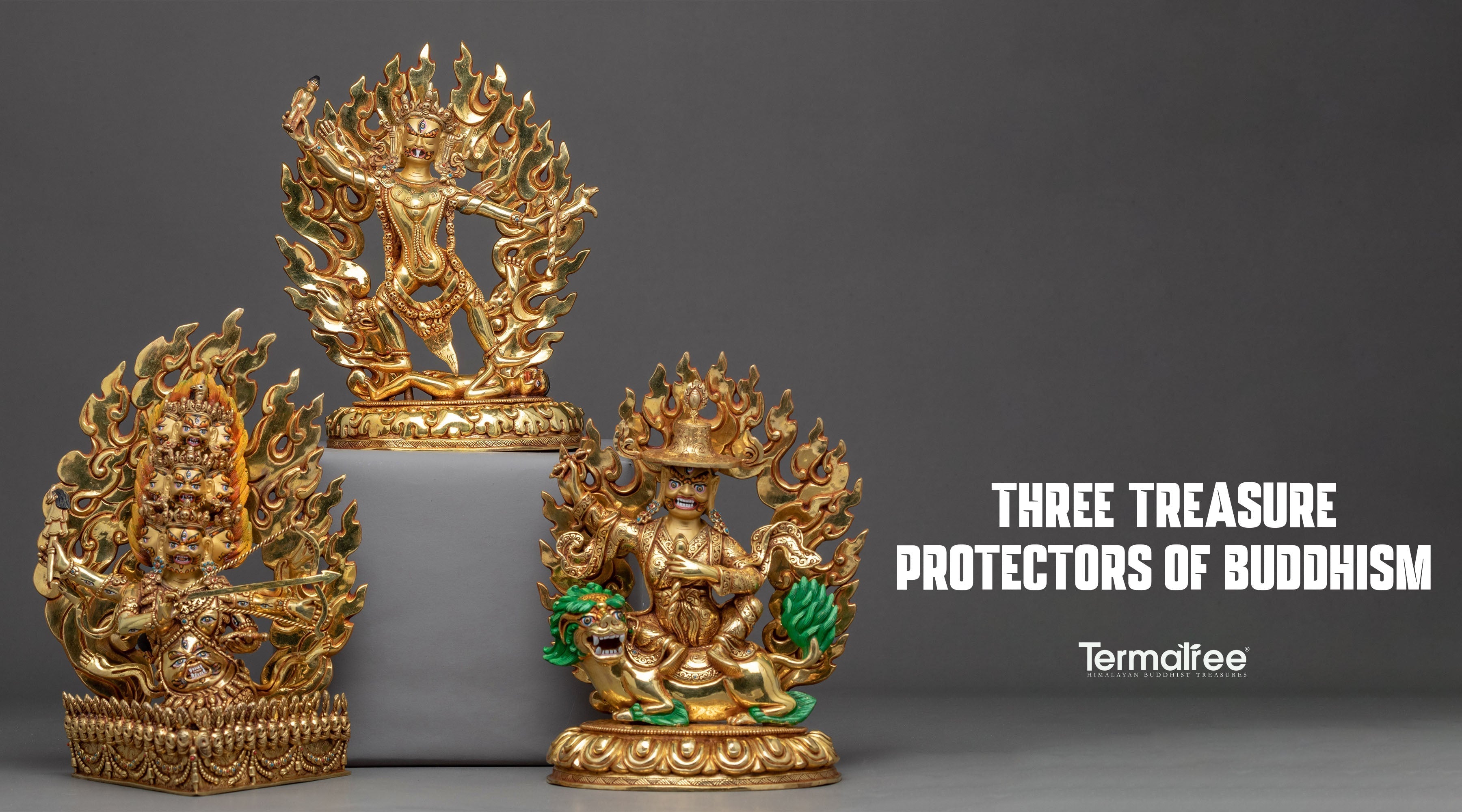The Allure of Ekajati, Rahula, and Dorje Legpa: Three Guardians
Within the intricate tapestry of Tibetan Buddhism, the Three Treasure Protectors—Ekajati, Rahula, and Dorje Legpa—hold a profound significance. Beyond mere mythological entities, these figures play a vital role in Buddhist practices, embodying rich symbolic meanings and fulfilling crucial spiritual functions.
Key Takeaways

- Ekajati, Rahula, and Dorje Legpa are crucial deities in Tibetan Buddhism, known for protecting the Dharma.
- These figures have unique iconographies that symbolize their roles and powers.
- They play a vital role in safeguarding both the teachings and practitioners of Buddhism.
The Cornerstones of the Buddhist Faith
The Three Jewels are the cornerstone of Buddhist belief and practice, offering a foundational framework for comprehending the Buddhist path. They serve as guiding principles and as a profound source of spiritual refuge for practitioners.
Historical Origins and Development
-
The Buddha: The Enlightened One
The first treasure, the Buddha, encompasses Siddhartha Gautama, the enlightened one, and the inherent Buddha nature within all beings.
Seeking refuge in the Buddha involves recognizing and aspiring to embody the enlightenment and virtues exemplified by Siddhartha Gautama. It goes beyond revering him as a historical figure; it entails acknowledging and nurturing the latent potential for awakening within oneself. -
The Dharma: The Teachings
The second jewel, the Dharma, pertains to the Buddha's teachings, spanning the entirety of Buddhist scriptures, doctrines, and guidance. It serves as a roadmap for comprehending the nature of reality, the essence of suffering, and the route to liberation.
The Dharma provides a structured approach to living a life that leads to alleviating suffering and attaining nirvana. To engage with the Dharma, one must study its teachings, reflect upon them, and actively incorporate them into one's life. -
The Sangha: The Community
The third jewel, the Sangha, conventionally denotes the ordained monks' and nuns' community. Yet, in a broader context, it encompasses all individuals, both laypeople and monastics, who embrace the Buddha's teachings.
The Sangha is a source of support, guidance, and companionship along the Buddhist journey, embodying a spiritual community with shared goals and practices. This communal environment fosters spiritual growth and provides a platform for continuous learning.
The Three Treasure Protectors
Ekajati: Deep Dive into Origins and Significance

Click here to view our Ekajati Gold Statue
Ekajati, a mystical figure in Tibetan Buddhism, holds the esteemed position of the principal guardian of Dzogchen teachings.
Rooted in ancient lore, her formidable presence goes beyond conventional protector roles, embodying removing obstacles and fostering spiritual growth. Ekajati's narrative intertwines with the evolution of the Tibetan Buddhism mirrors deep-seated beliefs in the supernatural safeguarding of the Dharma.
Detailed Analysis of Iconography and Symbols
Ekajati's depiction is both unique and symbolic. Her single eye, lone tuft of hair, and solitary breast extend beyond artistic choices, signifying her intense focus and power.
The singular look reflects her all-encompassing vision of overseeing the spiritual realm. The lone tuft of hair and breasts symbolize her unparalleled role in the spiritual hierarchy.
Her traditional weapons, a sword, and a noose, metaphorically represent her ability to cut through delusions and restrain harmful spirits, ensuring the safeguarding of the Dharma.
Rahula: Exploration of Mythological Background

Click here to view our Rahula Gold Statue
Rahula, originating from ancient Indian astrology, undergoes a captivating transformation from an 'Eclipse Demon' to a Buddhist protector.
This evolution reflects Buddhism's unique process of assimilating and reinterpreting indigenous deities. Rahula's shift from hostility to benevolence symbolizes Buddhism's core principle of transforming hostile forces into upbeat guardianship.
Comprehensive Look at Representation in Art
Examining artistic representations, Rahula is often portrayed in a serpentine form, enveloping the celestial bodies of the sun and moon. This imagery connects to his astrological origins, symbolizing his influence over cosmic events.
His formidable depiction in thangkas (Tibetan Buddhist paintings) and statues serves as a visual testament to the profound concept in Buddhist philosophy—where even the most evil energies can be subdued and harnessed for spiritual progression.
Dorje Legpa: In-Depth Historical Roots

Click here to view our Dorje Legpa Gold Statue
Dorje Legpa, originating as a deity in the pre-Buddhist Bon tradition, exemplifies the syncretic nature of Tibetan Buddhism.
His assimilation into the Buddhist pantheon underscores the religion's ability to absorb and transform local beliefs and deities. Dorje Legpa's crucial role as a guardian of the teachings emphasizes Buddhism's respect for and integration of indigenous spiritual elements.
Detailed Examination of Visual Depiction
A closer look at his visual representation reveals a rich and intricate iconography. Mounted on a snow lion, a symbol of fearlessness and power in Tibetan culture, he brandishes a vajra, symbolizing his unyielding and authoritative nature.
His fierce visage, a common theme among Dharma protectors, signifies his role in confronting spiritual adversaries and safeguarding the tenets of Buddhist teachings.
Roles and Functions
- Importance in Protecting the Dharma
The Three Protectors play a vital role in safeguarding and preserving the Dharma, serving as central figures in numerous rituals and prayers, particularly within Tibetan Buddhism. Invoked to ward off negative influences, their presence ensures the seamless transmission of teachings, representing a tangible force in the spiritual realm.
- Significance in Personal and Collective Guardianship
Their value extends beyond collective safeguarding, offering personal protection and guidance to practitioners. Invoking them in meditation and rituals is believed to dispel fears and surmount spiritual obstacles, fostering a supportive environment for individual growth and enlightenment.
In summary, Ekajati, Rahula, and Dorje Legpa transcend their roles as guardians of Buddhist teachings; they embody symbols of resilience, transformation, and spiritual protection. Their stories, iconography, and functions provide profound insights into Tibetan Buddhism, resonating with practitioners and enthusiasts of Buddhist philosophy worldwide. Their relevance continues to expand, offering guidance and inspiration in both spiritual and secular contexts.




